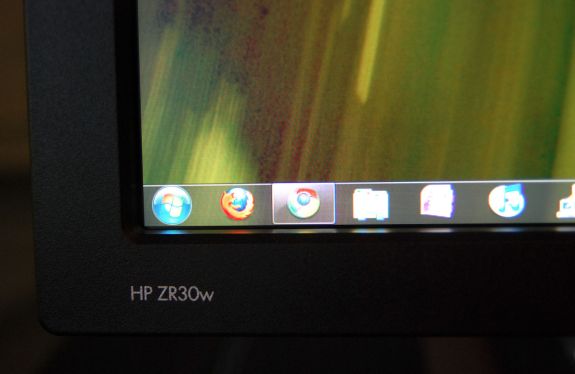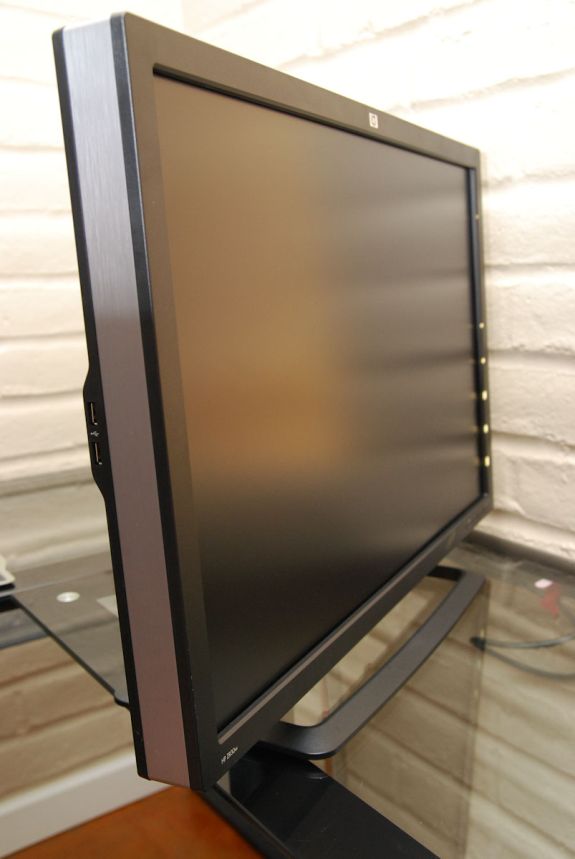A New 30" Contender: HP ZR30w Review
by Brian Klug on June 1, 2010 6:30 PM EST
Opining for an OSD
As I mentioned before, there’s no OSD to speak of. The only options exposed to users are input selection, brightness, and dynamic contrast. A blue LED at right flashes three times when you’ve reached the upper or lower brightness limits, and flashes four times when dynamic contrast is turned on, once when turned off. The LED is off when the display is in operation, and amber when in standby. The rest is up to you.
Spartan Scaling Selections
I also already touched on scaling which appears to be pretty barebones for reasons discussed earlier. You can pixel double by going with 1280x800, or go for native, or choose another resolution and everything upscaled with some smudging. There's no 1:1 option, or any options whatsoever. Honestly, I can’t think of any reasons why you wouldn’t drive an LCD at anything other than native resolution. The dot pitch of the ZR30w is fabulous at 0.250 mm, if you’re paying for those pixels, use them, then use DPI controls in the operating system if text and UI is too small. The ZR30w does scale other aspect ratios that I tested properly, but don't expect too much. Honestly it still makes no sense to drive a display this high resolution at anything but native.
Final Thoughts
The 30” segment of the LCD market demands the best of the best. It’s indisputably the ring in which every manufacturer wages battle with its flagship monitor. Solid execution here usually translates to solid performance for smaller size panels in the same lineup. Suffice it to say that HP’s 30 inch ZR series successor to the LP3065 doesn’t disappoint.
Spartan Scaling Selections
I also already touched on scaling which appears to be pretty barebones for reasons discussed earlier. You can pixel double by going with 1280x800, or go for native, or choose another resolution and everything upscaled with some smudging. There's no 1:1 option, or any options whatsoever. Honestly, I can’t think of any reasons why you wouldn’t drive an LCD at anything other than native resolution. The dot pitch of the ZR30w is fabulous at 0.250 mm, if you’re paying for those pixels, use them, then use DPI controls in the operating system if text and UI is too small. The ZR30w does scale other aspect ratios that I tested properly, but don't expect too much. Honestly it still makes no sense to drive a display this high resolution at anything but native.
Final Thoughts
The 30” segment of the LCD market demands the best of the best. It’s indisputably the ring in which every manufacturer wages battle with its flagship monitor. Solid execution here usually translates to solid performance for smaller size panels in the same lineup. Suffice it to say that HP’s 30 inch ZR series successor to the LP3065 doesn’t disappoint.
We would’ve liked to see just a bit more color accuracy, but the tradeoff for a dramatically bigger gamut is a good one to make. The ZR30w blew past the advertised 99% of AdobeRGB, coming in at just over 111% of the volume. It’s important to note that HP likely means coverage overlap of 99%, which the ZR30w does meet. But heck, having a volume bigger than the AdobeRGB volume is more notable. In person, the ZR30w is impressive all around. It’s bright, contrasty, and has colors that put my daily use monitors and others I’ve got laying around to shame; not an easy thing to do.
At an MSRP of $1,299, the ZR30w is priced aggressively and below its predecessor and competition. If you don’t mind lacking an extra DVI port, the increase in gamut volume is a notable difference. It’s likely that both lack of an OSD as well as accessory VGA, HDMI, component or composite inputs is related to the lack of a compatible control IC. Instead, there’s likely a simple scaler so we see minimal processing lag for an IPS panel, and unfortunately minimal user control. This is a bold move on HP’s part to continue for a second generation, but likely keeps cost and input processing lag low.
At an MSRP of $1,299, the ZR30w is priced aggressively and below its predecessor and competition. If you don’t mind lacking an extra DVI port, the increase in gamut volume is a notable difference. It’s likely that both lack of an OSD as well as accessory VGA, HDMI, component or composite inputs is related to the lack of a compatible control IC. Instead, there’s likely a simple scaler so we see minimal processing lag for an IPS panel, and unfortunately minimal user control. This is a bold move on HP’s part to continue for a second generation, but likely keeps cost and input processing lag low.
Interestingly enough, this is definitely the way that things are going for display controls, with a growing number offering DDC control as the exclusive option for tweaking settings. In practice, what HP offers with the front controls is almost all you need, so long as you can calibrate to your liking in software. Perhaps we might have gotten under a Delta E of 1.0 with some RGB sliders, but who’s to say?
The ZR30w is definitely a serious contender among 30” displays. It’s an attractive package that wows with above average color tracking, an impressive gamut, and a competitive price, but lacks some of the extra “accessory” inputs that consumers are starting to demand. That said, it looks like the ZR30w is a solid option if you’re looking for a 30” display with an unbeatable color gamut.












95 Comments
View All Comments
IceDread - Tuesday, September 21, 2010 - link
Good review, very good to keep at it with input lag, very important for me.This monitor would be the perfect one if it just would be 120Hz!
I so would love an ips panel at 30" with 120Hz!!
FXi - Friday, September 24, 2010 - link
Even if it had an HDMI connector it wouldn't go higher than 1920x1080. Check out other high res HP monitors that have HDMI. Dell is the same way. Despite HDMI "being able" to output higher resolutions, ALL PC monitor HDMI inputs only recognize as high as 1920x1200 and most only do 1920x1080. So don't wish for an HDMI port. It won't do you much good.FXi - Friday, September 24, 2010 - link
Since many folks debate the U2711 and the ZR30 and the U3008/3011, it would be interesting to see how things fall.As always, very disappointed the IPS hasn't YET managed after decades, to cure it's low contrast issues. Any TV owner will tell you that contrast and black level really make a display look fantastic and PC monitors are no different.
James5mith - Thursday, November 18, 2010 - link
Just wondering if anyone else has been able to get this monitor working on a Mac Pro with Dual-Link DVI.It would seem that DisplayPort bypasses the issue, but Dual-Link DVI fails to display. The monitor shows that it is getting a signal, the backlight is active, but the screen is blank. The Mac Pro thinks that the monitor is active, and has extended the display to it, but you cannot see anything.
Odd, issue, and I've confirmed that the display and cable work on other systems. It is just the Mac Pro that is having the issue. Wanted to use this as a replacement for a 30" ACD, but it looks like I'll be returning it instead.
Matrices - Friday, November 19, 2010 - link
It is so strange that you should mention this. I just received my monitor today and it has this exact same problem - except that it's defective across the board (on Windows 7 and Vista systems). Same symptoms, though: lights up, recognized by Windows, but displays absolutely nothing using the DVI. Nvidia cards don't have DP so I can't figure out if it's just the port that's defective or what. Anyway, I'm returning it, obviously.momofone - Friday, January 7, 2011 - link
I have a Dell workstation with nVidia Quadro FX 4500 with dvi-d connectors and I have exactly the same issue - blank screen. Acts like something should be displayed, i.e. the backlight is active, but nothing, nada, totally blank.Shame. Looks like this monitor is incompatible with the FX series workstation cards. I can connect the Apple 30" ACD and it work fine though. Looks like I will have to think about another ACD.
eajohnson - Tuesday, December 7, 2010 - link
I just bought a ZR30W last week and while it is performing well with no functional problems that I can see, the construction seems a little odd in that the panel is loose at the top (if I push very gently anywhere along the top of the panel, it can be pushed inward but stops after a few mm i.e. is not secured. Is this normal? Anyone know why it would be part of the design for it to be loose like that? At any of the other edges the panel appears to not be loose.I tried HP forums and calling HP tech support but they didn't seem to know, what I need is to find other owners that can try theirs and let me know if mine is normal or is defective.
SanFranShootr - Monday, January 3, 2011 - link
I've read on some other sites that Mac owners who have the ZR30W are having screen flicker problems when they updated from 10.6.4 to 10.6.5.Does anyone know whether this 10.6.5 problem has been resolved?
Rohirm - Saturday, January 8, 2011 - link
I have ZR30W connected via DP to Mac Pro Mid 2010 (HD5870). No problems here. Using OS X version 10.6.6NetJunky - Sunday, February 6, 2011 - link
I'm new on this website, but I have a question too. Will there be review of cheeper displays? Which one is better and why. Since I think, that not everyone can afford ZR30w.By the way, review was great. Very initeresting.